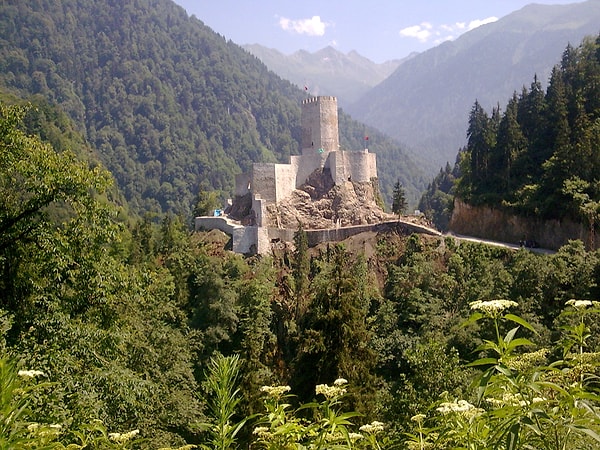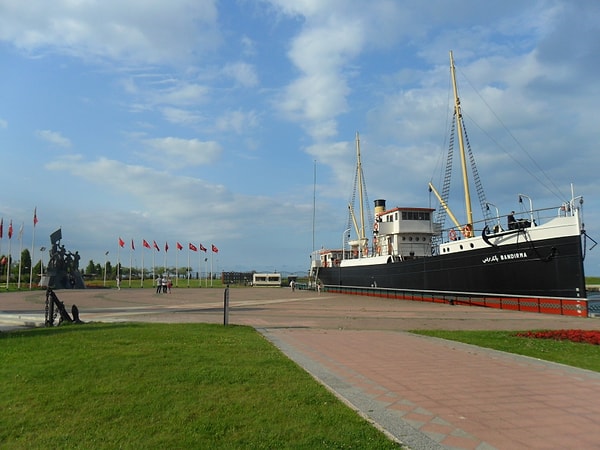Explore the Rich History of Turkey’s Black Sea Region: Must-See Landmarks
The Black Sea Region is renowned not only for its lush meadows, misty forests, and turbulent seas but also for its deep-rooted history spanning thousands of years. These lands, which bear traces of many civilisations from the Hittites to Byzantium, and from the Ottomans to the Republic, serve as an open-air museum for history enthusiasts. This cultural journey through ancient castles, monasteries, traditional mansions, and historic cities offers visitors unforgettable experiences. So, what to see in the Black Sea Region of Turkey? Where are the historical parts of the Black Sea Region in Turkey? Let's explore together 👇
1. Sümela Monastery – Trabzon

Located in the Altındere Valley National Park in the Maçka district of Trabzon, the Sümela Monastery was carved into the steep cliffs and built during the reign of Byzantine Emperor Theodosius I in the 4th century. According to legend, it was dedicated to the Virgin Mary by two monks from Athens, Barnabas and Sophronios. The monastery attracts attention with its frescoes, rock-carved structure, and unique location.
The monastery was expanded with the support of the Trabzon Empire from the 13th century onwards and continued to exist during the Ottoman period. Even after Mehmed II conquered Trabzon, Sümela was respected, with its maintenance and repair provided through foundations.
Visiting Tip: You can reach the monastery, where restoration work has been completed, by walking along nature trails. The view that emerges on foggy days offers perfect opportunities for photography enthusiasts.
2. Safranbolu Houses – Karabük

The Safranbolu district of Karabük is one of the most beautiful examples of Ottoman urban life that has survived to the present day. The district contains approximately 1,000 examples of civil architecture from the 18th and 19th centuries, and it was added to the UNESCO World Heritage List in 1994. Most houses reflect classical Ottoman house architecture with their courtyards and balconies.
The city has been a centre of trade for centuries due to its location on the historic Silk Road, adorned with inns, baths, fountains, and mosques. Other notable structures include the Cinci Inn and Bath, the Köprülü Mehmet Paşa Mosque, and the Yemeniciler Arastası.
Visiting Tip: You can stroll along the cobblestone streets of Safranbolu, enjoy Turkish coffee, and indulge in the local cuisine with saffron desserts.
3. Sinop Historical Prison – Sinop

Founded by the Colchians in the 7th century BC, Sinop is one of the oldest port cities on the Black Sea. The historic prison, located within the castle walls, was built as a castle in 1214 during the Seljuk period and converted into an official prison in 1887.
The prison, which remained in operation during the Republican era, is also of great literary significance, as it was here that Sabahattin Ali wrote his poem “Aldırma Gönül” (Don't Worry, My Heart). The cells, courtyards, and guard towers still retain their original structure.
Visitor Tip: While touring the museum, you can gain a closer feel for the lives of prisoners during that period with audio guide applications.
4. Zilkale – Rize

Zilkale, rising from the steep cliffs of the Fırtına Valley in the Çamlıhemşin district of Rize, was built by the Komnenos dynasty in the 14th century. The castle is located at an altitude of 750 metres and consists of an inner castle, an outer castle, and guard buildings.
It is one of the strongest castles built for defence in the Eastern Black Sea region. Rising amid the turbulent sounds of the Fırtına River, Zilkale is one of the most exquisite spots where the natural and historical beauties of the Black Sea come together.
Visiting Tip: You can also visit popular destinations such as Ayder Plateau in the region where the castle is located.
5. Amasra Castle – Bartın

Built on two promontories surrounded by the sea, Amasra Castle was constructed by the Byzantines and restored and used during the Genoese and Ottoman periods. The castle consists of two main sections: Sormagir and Zindan.
Used as a port city since Roman times, Amasra bears traces of the Hellenistic, Byzantine, and Ottoman periods. The castle walls, stonework, and mythological reliefs on them are noteworthy.
Visitor Tip: After exploring the castle, you can enjoy fresh seafood at Amasra's famous fish restaurants.
6. Bandırma Ferry and National Struggle Museum – Samsun

The Bandırma Ferry, which Atatürk used to land in Samsun on 19 May 1919 to launch the War of Independence, was converted into a museum in 2003. The museum is an exact replica of the ferry's interior, decorated with wax figures.
The ship museum includes the cabin where Atatürk travelled, the captain's cabin, and historical documents. The National Struggle Open Air Museum is also located in the same area as the museum.
Visiting Tip: This museum in the centre of Samsun is an ideal destination for learning history with children.
7. Hattuşaş Ancient City – Çorum

Hattuşaş, the capital of the Hittites, contains the remains of the first great empire established in Anatolia. Located in the Boğazkale district, this archaeological site attracts attention with its written historical documents, monumental gates, royal tombs, and extensive temple areas.
Included in the UNESCO World Heritage List in 1986, the Yazılıkaya Open Air Temple in the city is famous for its rock reliefs of Hittite gods.
Visiting Tip: If you visit during the summer months, you can also observe the excavation work.
8. Çakıroğlu İsmail Ağa Mansion – Trabzon

Built in 1805, this mansion is one of the finest examples of civil stone architecture in the Eastern Black Sea region. Belonging to the Çakıroğlu family, the building has palace-like details and sheds light on the social history of the region.
The two-story stone structure brings the traditional lifestyle to the present day with its carved wooden ceilings and stone wall decorations.
Visiting Tip: Located in the Of district of Trabzon, the mansion can be explored along with the surrounding mountain trails.
9. Giresun Castle – Giresun

Founded by Pontus King I. Pharnakes in the 2nd century BC, Giresun Castle is located at the highest point of the city. It is quite impressive with its sea view and panoramic city view.
Inside the castle, there are cisterns from the Ottoman period and a memorial tomb where Atatürk rested during his visit in 1924. The view of Giresun Island can be seen from here.
Visiting Tip: If you visit the castle at sunset, you can witness one of the most beautiful sunsets on the Black Sea.
Source: Kültür Portalı
10. Aydıntepe Underground City – Bayburt

Located in the Aydıntepe district of Bayburt, this underground city consists of tunnels and rooms carved entirely out of tuff rock. The structure, which is approximately 1,200 meters long, is thought to date back to 3000 BC.
This city, which includes living areas, ventilation shafts, and water channels, is one of the northernmost examples of Anatolia's underground living tradition.
Visitor Tip: Taking a guided tour will help you better understand which periods the structure belongs to.
Source: Aydıntepe Belediyesi
Keşfet ile ziyaret ettiğin tüm kategorileri tek akışta gör!

Send Comment